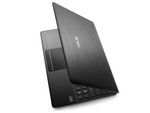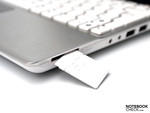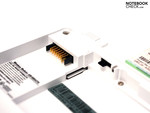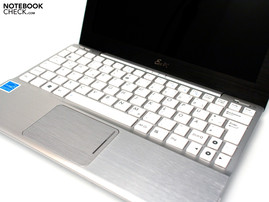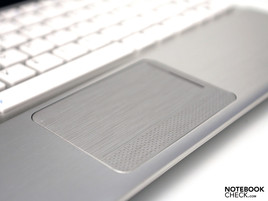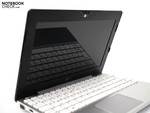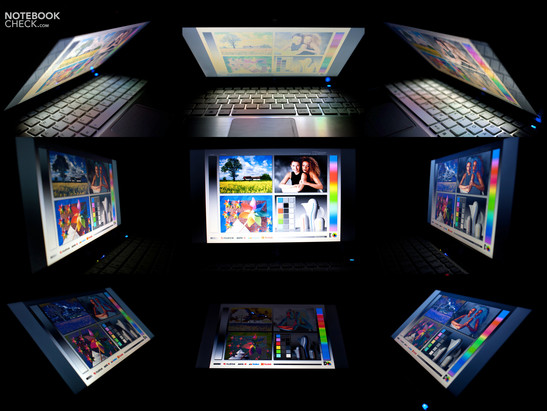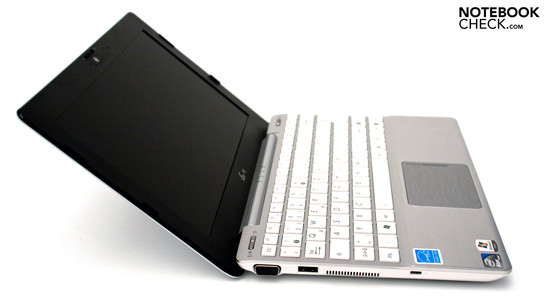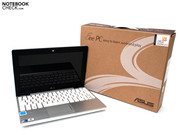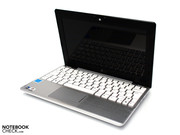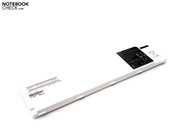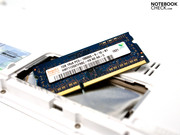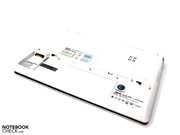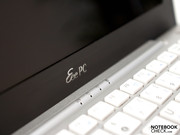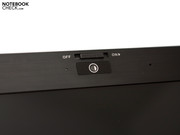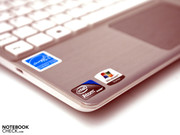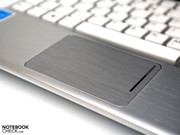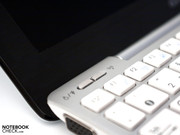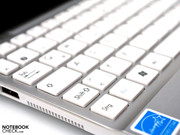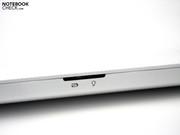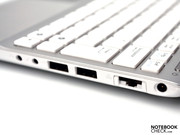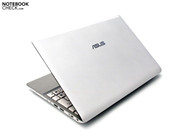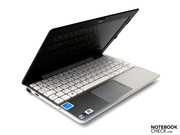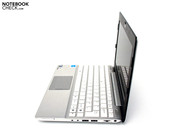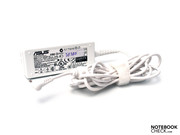Review Asus Eee PC 1018P Netbook

The Asus Eee PC 1018P/1018PB represents the top model in the new Eee range. Different than its little brother (Asus Eee PC 1015P), the case is made of aluminum and the latest USB 3.0 ports are available for a surcharge. The 1018P's insides aren't very different to usual netbooks and the well known Intel Atom N455 with DDR3 support (1.66 GHz, single core) is found.
Would you like more? The Asus Eee PC 1018PB has, aside from the mentioned USB 3.0 ports (2 USB 3.0, 1 USB 2.0), the faster Intel Atom N475 (1.86 GHz, single core) and a fingerprint scanner, as well. This "upgrade" is affordable and costs an additional 30 euro (429 euro, RRP).
This device is also to be convincing particularly in the areas of ergonomics, display and workmanship. The touchpad with a separate scroll field and patterned mouse replacement keys, as well as a generous chiclet keyboard are new for example. The Asus Eee PC 1018P is available in white (color combination: white, silver, black) and black, whereas the surfaces are allegedly resistant to fingerprints and dust.
A few configuration details first: aside from Intel's Atom N433 with a clock rate of 1.66 GHz, there is a glossy 10.1 inch display, a 1 GB DDR3 10600S RAM that clocks with 800 MHz, a 250 GB hard disk memory, a Bluetooth 3.0 controller and WLAN standard 802.11 b/g/n. Our test device with this configuration costs 399 euro (RRP), whereby the superiorly equipped Asus Eee PC 1018PB has a price tag of 429 euro (RRP).
Case
The slim design and the high-end materials used strikes us right away after unpacking. The Asus Eee PC 1018P doesn't only have a nice look due to the new design. The case's construction height has also decreased noticeably to 2.19 centimeters at its thickest point. Our white test device has a combination of white, silver (aluminum) and dark gray (almost black) body parts. The display lid and the case's bottom are kept white and have a chic pattern. The area around the keyboard is convincing with a high-end aluminum surface, which has been made of one piece. The display bezel is dark gray to black, as "Asus typical" for white devices, which fits well into the concept due to the aluminum look.
The applied materials also have repellent surfaces that are supposed to decrease fingerprints and dust. Merely the glossy screen attracts these magically. A good job has been done with the workmanship and the whole design looks balanced and modern. The display lid is very slim due to the LED backlight, but is torsion resistant at the same time. The big display hinge in the center is also new in this area, which also accommodates various status LEDs and two stereo loudspeakers. This solution is very elegant and handy because the display can be opened to a maximum of 150 degrees. Merely a slight teetering of the display remains to be a reason for complaint in this issue.
The dimension of 26.2 x 17.9 x 1.8 - 2.19 centimeters (w x d x h) are in a normal range. Especially, the reduced construction height is a positive factor. The netbook only weighs 1.12 kilograms with the inserted 6 cell battery (44 WH). Matching to that, Asus includes a small adapter that only weighs 180 grams and which is very compact. The 6 cell battery is located underneath the wrist-rest in this device, shifting the center of gravity a bit. A positive side effect: the case bottom doesn't have to be held down when the display lid is opened!
Connectivity
Available Connections
Despite the upscale price, the 1018P only has the standard interfaces on its sides. There is a VGA-out for connecting a monitor or laptop projector, a USB 2.0 port and the Kensington Lock slot for protecting the netbook against theft on the left. Moreover, the vents for warm waste air have turned out very small.
In comparison, the right has a greater amount of ports. The often used 3-in-1 cardreader (SD, SDHC, MMC), the audio sockets (headphone-out, microphone-in), two USB 2.0 ports, a RJ network jack and the power socket for the included AC adapter are found here. The connection for a network cable is inserted into the case elegantly by a moveable cover and is inconspicuous. This device's front and rear side is completely free of interfaces or other components in this special case. Asus has integrated the battery into the case's bottom (removable) and the stereo loudspeakers are in the big display hinge.
In view of available place and design, Asus has done a good job with the positioning. Every interface has enough room and the implementation into the case design is convincing. The circumference can only be described as being "netbook standard". Fortunately, Asus has the Eee PC 1018PB for 429 euro (RRP). This netbook has two USB 3.0 ports on the right and a fingerprint scanner on the wrist-rest. We deem the surcharge of 30 euro in this regard for justified and appropriate.
Communication
In accordance with today's standard, the netbook from Asus has a wide range in the field of mobile technologies. Aside from a Gigabit Ethernet (Atheros AR8132), there is a WLAN standard 802.11n controller from Broadcom. Additionally, a fast Bluetooth 3.0 is onboard, which guarantees fast transmissions between netbook and a mobile device. Just like the smaller Asus Eee 1015P, the 1018P netbook is equipped with a dummy slot for a SIM card. If and when a device with an integrated UMTS module ala "1018PM" or "1018BM" will be available is not known.
Scope of Delivery and Supplies
The scope of delivery turns out very meager despite the high start price of 399 euro (RRP). Beside the device, the matching AC adapter with power cable, a user's manual, the 6 cell battery with a capacity of 44 WH and the warranty card is found. We would have at least expected a neoprene sleeve in this price range.
Input Devices
Keyboard
Asus' new netbook range (1015P, 1016P and 1018P) is equipped with chiclet keyboards. This single-key layout is supposed to primarily improve ergonomics. Our test device has a white layout, which is well legible and has already been used often. The keys have a good and pleasant pressure point and stroke length with their size of 14 x 14 millimeters. Unfortunately, the shift keys turn out very small in this device and typos can't be avoided. The given FN functions are quite extensive and well visible due to a light blue color. Additionally, there are two hardware, respectively software, buttons above the keyboard's left. With these, mobile technologies and/or performance profiles of Asus' "Super Hybrid Engine" can be addressed or ExpressGate Instant OS can be started when the device is turned off.
Touchpad
In comparison to the Eee PC 1015P, Asus relies on a more professional touchpad in this top model, which has a clear layout. This stands out from the wrist-rest by a darker surface and has a pleasant texture in an aluminum look. It has a scroll area on its right that is also available for navigation during normal use. This results in a feasible diagonal of 8.5 centimeters. Naturally, modern multi-touch gestures are also supported. The mouse keys stand out from the rest by a dimpled surface. The keys have a crisp pressure point with a short stroke length that is quite pleasant.
Display
Why Asus? The Asus Eee PC 1015P and R101 had realized our hopes: a matt 10.1 inch screen with good rates. A glare type display, with a native resolution of 1024x600 pixels, is used again in our test device. An interpolated (higher) resolution isn't available under Windows 7 starter and you have to live without a HD screen (1366x768 pixels, 720p), or a matt display surface. We would have been delighted about a matt 10.1 inch display, and ask ourselves why Asus hasn't used the 1015P's screen, as it was impressive in our review.
Modern LED lighting makes an even and bright illumination possible besides a slim design. The display can however only position itself in the wide center field with a maximum brightness of 206 cd/m2 and an average rate of 190.9 cd/m2. A stronger light would advocate the display and a good outdoor use.
| |||||||||||||||||||||||||
Brightness Distribution: 82 %
Contrast: 159:1 (Black: 1.23 cd/m²)
Unfortunately, the illumination of the entire display surface is only 82 percent, despite the LED backlight which is usually very even. Another drawback is the low contrast (159:1), which is due to an increased black value (1.23 cd/m2). The subjective impression of color representation and focus is convincing in normal use, though.
Outdoor use is restricted by the high-gloss surface and average measured rates. Direct sunlight or light incidence is the biggest problem because the image becomes illegible and you have to stop work. Indirect light fortunately only prevents work only slightly, and the Eee PC can be used with a few deficiencies.
The viewing angle stability leaves mixed feelings. Horizontal movements aren't a problem and the image remains stable and legible up to about 170 degrees. However, a slight deviation from the ideal viewing position on the vertical plane is enough to create the impression of a negative. The presented colors fortunately stay stable and falsifications aren't noticed.
Performance
Intel's newest hardware is found inside the Asus Eee PC 1018P. The Intel Atom N455 doesn't have any more performance, in comparison to Intel's Atom N450. However, it bids support for current DDR3 RAMs (DDR3-10600S), which clocks faster and is more future proof. Naturally, the "Super Hybrid Engine" hasn't been forgotten. The processor can be overclocked, respectively downclocked, marginally via this software in order to achieve a longer battery life. This supplies a performance range of 997 MHz ("Power Savings Mode") up to 1.69 GHz ("Super Performance Mode").
The other hardware equipment is known and promises an average office performance under Windows 7 Starter. The Intel GMA 3150 is responsible for graphics. It is only suitable for games to an extent with a core rate of 200 MHz. Moreover, there is a 1 GB DDR3 10600S RAM that operates with 800 MHz and a 250 GB sized notebook hard disk (2.5 inch) from Seagate. The extendability is limited due to the lack of a maintenance cover on the bottom. Merely the RAM can be upgraded to a maximum of 2 GBs after removing the battery. The case has to be disassembled for exchanging the hard disk, which can be very difficult in certain circumstances and may result in a loss of warranty.
We determined the used hardware's performance with various benchmarks. For this, Windows 7 Starter's (32 bit) high performance mode and the "Super Performance Mode" of the Super Hybrid Engine were enabled. The Intel Atom N455 clocks with 1.69 GHz in this combination and thus bids a slight performance gain.
The application performance hasn't improved in comparison to the Asus Eee PC 1015P. The rates are very close, whereby only an average office performance is supplied. Subjectively, the windows build up is very slow and the booting times aren't convincing. It's advisable to upgrade to a 2 GB RAM despite the stripped-down Windows 7 Starter from Microsoft because the operating system uses the largest part of the existing memory.
| PCMark 05 Standard | 1295 points | |
| PCMark Vantage Result | 1053 points | |
Help | ||
A netbook with these or similar components is far away from a strong 3D performance and only simple 3D games can be played in a low resolution. 3DMark06 verifies only minimal rates in a resolution of 1280x1024 pixels. Our test device joins in on most 10.1 inch netbooks with and Intel GMA 3150 graphics unit with a total score of 131 points. Small and comparatively more inexpensive subnotebooks with an 11.6 inch screen supply a better performance (examples: Acer Aspire 1551, Dell Inspiron M101z). The second edition of Alienware's M11x (R2) with an Intel Core i5-520UM and Nvidia GeForce GT 335M provides significantly more power.
| 3DMark 2001SE Standard | 2320 points | |
| 3DMark 03 Standard | 685 points | |
| 3DMark 05 Standard | 302 points | |
| 3DMark 06 Standard Score | 131 points | |
Help | ||
The 1018P is equipped with a 2.5 inch drive ex-factory, which has a gross capacity of 250 GB. The Seagate Momentus 5400.6 (ST9250315AS) is used fairly often by Asus and has a sufficient performance for daily use. However, you shouldn't expect any miracles with a maximum transfer rate of 76.5 MB per second. A faster hard disk or a modern solid state drive (SSD), which is currently still quite expensive though, is recommendable for fans of short booting times.
Emissions
System Noise
The cooling system should also work very quietly, aside from supplying a good output. The small fan inside emits a consistent 29.1 dB(A) in normal mode. Thus, it's hardly audible and working turns out to be pleasant. The hard disk also works inconspicuously with 29.5 dB(A) and clacking or other noises don't turn up. Astonishingly, these rates only increase slightly under load and you hardly ever hear it with a maximum of 31.1 dB(A). The cooling system performs overall very quietly and is able to impress us.
Noise Level
| Idle |
| 29.1 / 29.1 / 29.1 dB(A) |
| HDD |
| 29.5 dB(A) |
| Load |
| 29.5 / 31.1 dB(A) |
 | ||
30 dB silent 40 dB(A) audible 50 dB(A) loud |
||
min: | ||
Temperature
The hardware's temperature development is kept within limits and the system is generally convincing. We could measure a maximum of 40.6 degrees Celsius in idle mode. But this rate is out of the wrist-rest's range, and as so often in the area of the vents for the warm waste air. The area around the touchpad always stays cool with a maximum of 28.5 degrees Celsius.
The temperatures under load increase to a maximum of 42.5 degrees Celsius and are thus in a higher range. This rate is again found in the fan output area and you can feel a warming on the case's surface. The included adapter is within limits with a maximum of 38.7 degrees Celsius, though.
(+) The maximum temperature on the upper side is 32.5 °C / 91 F, compared to the average of 33.1 °C / 92 F, ranging from 21.6 to 53.2 °C for the class Netbook.
(±) The bottom heats up to a maximum of 42.5 °C / 109 F, compared to the average of 36.6 °C / 98 F
(+) In idle usage, the average temperature for the upper side is 30.1 °C / 86 F, compared to the device average of 29.8 °C / 86 F.
(+) The palmrests and touchpad are cooler than skin temperature with a maximum of 29.1 °C / 84.4 F and are therefore cool to the touch.
(±) The average temperature of the palmrest area of similar devices was 29.3 °C / 84.7 F (+0.2 °C / 0.3 F).
Loudspeakers
The repositioned stereo loudspeakers are now found in the large display hinge, but only have the usual poor sound, anyway. The high pitches are present, but basses and lower pitches aren't existent.
The netbook has a 3.5 millimeter jack for a better audio output. An external sound system or headphones can be connected via this port. The sound is subjectively convincing and we don't notice static.
Battery Life
The power consumption of the Intel N455 with integrated GMA 3150 graphics unit is definitely a big advantage of this combination - especially in view of battery life. The Eee PC consumes between 5.4 and 7.7 watts in normal use. These consumption rates increase to a maximum of 11.4 watts under load. We noticed that the N455 in our test device was more economical than the N450 in previous tests. The hardware's lower power consumption and a larger 6 cell battery, with 44 WH, speak for the 1018P and the corresponding runtimes.
The minimum battery runtime can be determined with BatteryEater's "Classic Test". We executed an OpenGL graphics and CPU calculation with maximum display brightness and enabled WLAN module. Additionally, we activated Windows 7's high performance mode and the "Super Performance Mode". This combination overclocks the processor to 1.60 GHz. This marginally more performance isn't noticed, but the power consumption should increase, theoretically. The battery's charge is completely exhausted after 4 hours and 19 minutes and the device can't be turned on any more. Checking or writing a few emails or surfing on the internet via WLAN with a pleasant display brightness can be enjoyed to the full thanks to the 6 cell battery. It's time to look for an electrical outlet after well 7 hours and 22 minutes.
Use under minimum load is the Super Hybrid Engine's true strength. The "Reader's Test" simulates reading a text document without much load, whereas the WLAN module is disabled and the minimum display brightness is selected. The Asus software throttles the processor to 997 MHz and reduces the power consumption in "Power Savings Mode". You shouldn't expect any computing performance in this case, but the runtime of 9 hours and 46 minutes is impressive. This equals about a long day in the office and is completely sufficient.
| Off / Standby | |
| Idle | |
| Load |
|
Key:
min: | |
Verdict
The Asus Eee PC 1018P is Asus' new 10.1 inch netbook top model, which particularly convinces with its new case and revised design. Naturally, it has its shortcoming, which we almost always discover. The weak performance of Intel's Atom N455 with a DDR3 RAM isn't a surprise and we are waiting for the dual core performance of Intel's Atom N550.
The familiar chiclet keyboard layout and the good touchpad are convincing. The screen would finish off the Trio of Perfect Ergonomics. Regrettably, Asus has again used a glare type screen, whose rates don't convince and whose outdoor use is suboptimal.
The configuration is basically nothing special and we would have thought the scope of delivery would be larger in view of the upscaled price. The large display hinge, which now accommodates the status LEDs and the still poor loudspeakers, is new and very elegantly solved. We deem the Asus Eee PC 1018PB worth praise, which has two USB 3.0 ports for a mere surcharge of 30 euro, the faster Intel Atom N475 (1.86 GHz, single core) and a fingerprint scanner.
The Asus Eee PC 1018 leaves us with a good impression because the netbook is impressive in important matters and sets a standard in regards to the case. Both the Eee PC 1018P for 399 euro (RRP), as well as the 1018 for 429 euro (RRP) is slowly appearing on the market. Asus states the launch to be in the third quarter of 2010 (Q3 2010).
» Asus Eee PC 1018P currently available starting at 399.00 at Amazon




